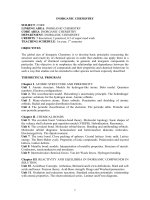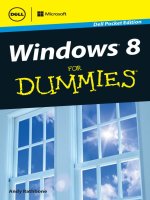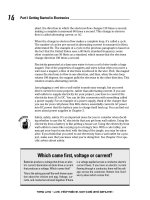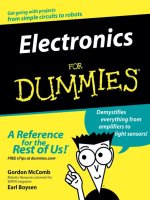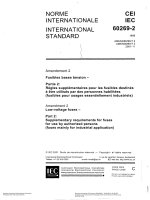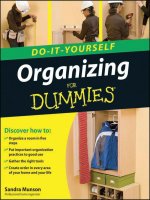Inorganic chemistry for dummies by michael matson, alvin w orbaek
Bạn đang xem bản rút gọn của tài liệu. Xem và tải ngay bản đầy đủ của tài liệu tại đây (14.79 MB, 387 trang )
Inorganic
Chemistry
Inorganic
Chemistry
by Michael L. Matson and Alvin W. Orbaek
Inorganic Chemistry For Dummies®
Published by
John Wiley & Sons, Inc.
111 River St.
Hoboken, NJ 07030-5774
www.wiley.com
Copyright © 2013 by John Wiley & Sons, Inc., Hoboken, New Jersey
Published by John Wiley & Sons, Inc., Hoboken, New Jersey
Published simultaneously in Canada
No part of this publication may be reproduced, stored in a retrieval system or transmitted in any form or by
any means, electronic, mechanical, photocopying, recording, scanning or otherwise, except as permitted
under Sections 107 or 108 of the 1976 United States Copyright Act, without either the prior written permission of the Publisher, or authorization through payment of the appropriate per-copy fee to the Copyright
Clearance Center, 222 Rosewood Drive, Danvers, MA 01923, (978) 750-8400, fax (978) 646-8600. Requests to
the Publisher for permission should be addressed to the Permissions Department, John Wiley & Sons, Inc.,
111 River Street, Hoboken, NJ 07030, (201) 748-6011, fax (201) 748-6008, or online at ey.
com/go/permissions.
Trademarks: Wiley, the Wiley logo, For Dummies, the Dummies Man logo, A Reference for the Rest of Us!,
The Dummies Way, Dummies Daily, The Fun and Easy Way, Dummies.com, Making Everything Easier, and
related trade dress are trademarks or registered trademarks of John Wiley & Sons, Inc. and/or its affiliates
in the United States and other countries, and may not be used without written permission. All other trademarks are the property of their respective owners. John Wiley & Sons, Inc., is not associated with any
product or vendor mentioned in this book.
LIMIT OF LIABILITY/DISCLAIMER OF WARRANTY: THE PUBLISHER AND THE AUTHOR MAKE NO
REPRESENTATIONS OR WARRANTIES WITH RESPECT TO THE ACCURACY OR COMPLETENESS OF
THE CONTENTS OF THIS WORK AND SPECIFICALLY DISCLAIM ALL WARRANTIES, INCLUDING WITHOUT LIMITATION WARRANTIES OF FITNESS FOR A PARTICULAR PURPOSE. NO WARRANTY MAY BE
CREATED OR EXTENDED BY SALES OR PROMOTIONAL MATERIALS. THE ADVICE AND STRATEGIES
CONTAINED HEREIN MAY NOT BE SUITABLE FOR EVERY SITUATION. THIS WORK IS SOLD WITH THE
UNDERSTANDING THAT THE PUBLISHER IS NOT ENGAGED IN RENDERING LEGAL, ACCOUNTING, OR
OTHER PROFESSIONAL SERVICES. IF PROFESSIONAL ASSISTANCE IS REQUIRED, THE SERVICES OF
A COMPETENT PROFESSIONAL PERSON SHOULD BE SOUGHT. NEITHER THE PUBLISHER NOR THE
AUTHOR SHALL BE LIABLE FOR DAMAGES ARISING HEREFROM. THE FACT THAT AN ORGANIZATION
OR WEBSITE IS REFERRED TO IN THIS WORK AS A CITATION AND/OR A POTENTIAL SOURCE OF FURTHER INFORMATION DOES NOT MEAN THAT THE AUTHOR OR THE PUBLISHER ENDORSES THE INFORMATION THE ORGANIZATION OR WEBSITE MAY PROVIDE OR RECOMMENDATIONS IT MAY MAKE.
FURTHER, READERS SHOULD BE AWARE THAT INTERNET WEBSITES LISTED IN THIS WORK MAY HAVE
CHANGED OR DISAPPEARED BETWEEN WHEN THIS WORK WAS WRITTEN AND WHEN IT IS READ.
For general information on our other products and services, please contact our Customer Care
Department within the U.S. at 877-762-2974, outside the U.S. at 317-572-3993, or fax 317-572-4002.
For technical support, please visit www.wiley.com/techsupport.
Wiley also publishes its books in a variety of electronic formats and by print-on-demand. Some content
that appears in standard print versions of this book may not be available in other formats. For more information about Wiley products, visit us at www.wiley.com.
Library of Congress Control Number: 2013932110
ISBN 978-1-118-21794-8 (pbk); ISBN 978-1-118-22882-1 (ebk); ISBN 978-1-118-22891-3 (ebk);
ISBN 978-1-118-22894-4 (ebk)
Manufactured in the United States of America
10 9 8 7 6 5 4 3 2 1
About the Authors
Michael L. Matson started studying chemistry at the U.S. Naval Academy in
Annapolis, Maryland. After leaving the Navy, Michael started a PhD program
at Rice University, studying the use of carbon nanotubes for medical diagnosis and treatment of cancer. Specifically, Michael focused on internalizing
radioactive metal ions within carbon nanotubes: Some radioactive metals
could be pictured with special cameras for diagnosis, whereas others were
so powerful they could kill cells for treatment. It was at Rice that Michael and
Alvin met. Following Rice, Michael went to the University of Houston-Downtown
to begin a tenure-track professorship. Happily married to a woman he first
met in seventh grade, Michael has two young children, a yellow Labrador
retriever named Flounder, is a volunteer firefighter and sommelier, and
enjoys CrossFitting.
Alvin W. Orbaek was introduced to chemistry at Rice University (Houston,
Texas) by way of nanotechnology, where he studied single-walled carbon
nanotubes, transition metal catalysts, and silver nanoparticles. He had
previously received a degree in Experimental Physics from N.U.I. Galway
(Ireland) and moved into the study of space science and technology at the
International Space University (Strasbourg, France). He received a position on Galactic Suite, an orbiting space hotel. To date, he enjoys life by
sailing, snowboarding, and DJing. He has been spinning vinyl records since
the Atlantic Hotel used to rave, and the sun would set in Ibiza. He hopes to
empower people through education and technology, to that effect he is currently completing a PhD in Chemistry at Rice University.
Dedications
Michael: To my wife, Samantha.
Alvin: To Declan, Ann Gitte, Anton, Anna-livia, and Bedstemor.
Authors’ Acknowledgments
Michael: I’d like to acknowledge the immeasurable amounts of assistance
from Matt Wagner, Susan Hobbs, Lindsay Lefevere, Alecia Spooner, and
Joan Freedman.
Alvin: Without John Wiley & Sons, there would be no book, and for that I
am very grateful. Particularly because of the very positive and professional
attitude by which they carry out their business; thanks for getting it done. It
was a blessing to work with you. In particular, I would like to mention Alecia
Spooner, Susan Hobbs (Suz), and Lindsay Lefevere, and thanks to the technical editors (Reynaldo Barreto and Bradley Fahlman) for their crucial input.
I would also like to thank Matt Wagner for invaluable support and assistance.
And to Mike Matson, thank you for the invitation to write this book.
I have had many teachers, mentors, and advisors throughout the years, but
there are five who deserve attention. Andrew Smith at Coleenbridge Steiner
school, where I enjoyed learning a great deal. John Treacy, who made every
science class the most riveting class each day. Pat Sweeney, whose habit of
teaching would leave anyone engrossed in mathematics. To Ignasi Casanova
for his mentorship and introduction to the nanos. And Andrew Barron, both
my PhD advisor and mentor, to whom I owe a great deal of credit, due in no
small part to his measure of tutelage.
But all this stands upon a firm foundation that is based on the support of
Dec, Gitte, Anton, and Anna; here’s to next Christmas — whenever. There are
many other friends and family who have contributed to this work, too many
to mention them all. But I’d especially like to thank my colleagues from the
Irish house, who so graciously agreed to read through the text, namely Alan
Taylor, Nigel Alley, and Stuart Corr. Also to Sophia Phounsavath and Brandon
Cisneros for proofreading. Jorge Fallas for the Schrödinger equation. To
Gordon Tomas for continued support of my writing. And to Gabrielle Novello,
who fed me wholesome foods while I otherwise converted coffee and sleepless nights into this book. And to Valhalla for those nights when work was
not working for me. And to PHlert, the best sailing program on this planet, or
any other.
Publisher’s Acknowledgments
We’re proud of this book; please send us your comments at .
For other comments, please contact our Customer Care Department within the U.S. at 877-762-2974,
outside the U.S. at 317-572-3993, or fax 317-572-4002.
Some of the people who helped bring this book to market include the following:
Acquisitions, Editorial, and
Media Development
Composition Services
Project Editor: Susan Hobbs
Acquisitions Editor: Lindsay Lefevere
Copy Editor: Susan Hobbs
Assistant Editor: David Lutton
Editorial Program Coordinator: Joe Niesen
Project Coordinator: Sheree Montgomery
Layout and Graphics: Carrie A. Cesavice,
Joyce Haughey, Brent Savage
Proofreaders: Lindsay Amones,
John Greenough, Jessica Kramer
Indexer: BIM Indexing & Proofreading Services
Technical Editors: Reynaldo Barreto,
Bradley Fahlman
Editorial Manager: Carmen Krikorian
Editorial Assistant: Rachelle Amick
Art Coordinator: Alicia B. South
Cover Photo: © Laguna Design / Science Source
Cartoons: Rich Tennant (www.the5thwave.com)
Publishing and Editorial for Consumer Dummies
Kathleen Nebenhaus, Vice President and Executive Publisher
Publishing for Technology Dummies
Andy Cummings, Vice President and Publisher
Composition Services
Debbie Stailey, Director of Composition Services
Contents at a Glance
Introduction................................................................. 1
Part I: Reviewing Some General Chemistry..................... 7
Chapter 1: Introducing Inorganic Chemistry.................................................................. 9
Chapter 2: Following the Leader: Atomic Structure and Periodic Trends................ 21
Chapter 3: The United States of Oxidation.................................................................... 39
Chapter 4: Gone Fission: Nuclear Chemistry................................................................ 53
Chapter 5: The ABCs: Acid-Base Chemistry.................................................................. 69
Part II: Rules of Attraction: Chemical Bonding............. 81
Chapter 6: No Mr. Bond, I Expect You to π: Covalent Bonding................................... 83
Chapter 7: Molecular Symmetry and Group Theory.................................................. 101
Chapter 8: Ionic and Metallic Bonding......................................................................... 121
Chapter 9: Clinging to Complex Ions: Coordination Complexes............................... 143
Part III: It’s Elemental: Dining at the Periodic Table.... 159
Chapter 10: What the H? Hydrogen!............................................................................. 161
Chapter 11: Earning Your Salt: The Alkali and Alkaline Earth Metals...................... 171
Chapter 12: The Main Groups....................................................................................... 183
Chapter 13: Bridging Two Sides of the Periodic Table: The Transition Metals...... 207
Chapter 14: Finding What Lies Beneath: The Lanthanides and Actinides............... 221
Part IV: Special Topics.............................................. 233
Chapter 15: Not Quite Organic, Not Quite Inorganic: Organometallics................... 235
Chapter 16: Accelerating Change: Catalysts............................................................... 253
Chapter 17: Bioinorganic Chemistry: Finding Metals in Living Systems................. 267
Chapter 18: Living in a Materials World: Solid-State Chemistry............................... 287
Chapter 19: Nanotechnology......................................................................................... 305
Part V: The Part of Tens............................................ 313
Chapter 20: Ten Nobels.................................................................................................. 315
Chapter 21: Tools of the Trade: Ten Instrumental Techniques................................ 319
Chapter 22: Ten Experiments........................................................................................ 323
Chapter 23: Ten Inorganic Household Products........................................................ 329
Glossary.................................................................. 335
Index....................................................................... 343
Table of Contents
Introduction.................................................................. 1
About This Book............................................................................................... 1
Conventions Used in This Book...................................................................... 2
What You Don’t Need to Read........................................................................ 2
Foolish Assumptions........................................................................................ 2
How This Book Is Organized........................................................................... 3
Part I: Reviewing Some General Chemistry......................................... 3
Part II: Rules of Attraction: Chemical Bonding.................................... 4
Part III: It’s Elemental: Dining at the Periodic Table........................... 4
Part IV: Special Topics........................................................................... 4
Part V: The Part of Tens......................................................................... 5
Icons Used in This Book.................................................................................. 5
Where to Go from Here.................................................................................... 6
Part I: Reviewing Some General Chemistry...................... 7
Chapter 1: Introducing Inorganic Chemistry . . . . . . . . . . . . . . . . . . . . . . 9
Building the Foundation.................................................................................. 9
Losing your electrons........................................................................... 10
Splitting atoms: Nuclear chemistry.................................................... 11
Changing pH.......................................................................................... 12
Getting a Grip on Chemical Bonding............................................................ 12
Traveling Across the Periodic Table............................................................ 13
Hyping up hydrogen............................................................................. 14
Moving through the main groups....................................................... 15
Transitioning from one side of the table to another........................ 15
Uncovering lanthanides and actinides............................................... 16
Diving Deeper: Special Topics...................................................................... 16
Bonding with carbon: Organometallics............................................. 17
Speeding things up: Catalysts............................................................. 17
Inside and out: Bio-inorganic and environmental chemistry.......... 17
Solid-state chemistry............................................................................ 18
Nanotechnology.................................................................................... 19
Listing 40 More............................................................................................... 19
xii
Inorganic Chemistry For Dummies
Chapter 2: Following the Leader: Atomic Structure
and Periodic Trends . . . . . . . . . . . . . . . . . . . . . . . . . . . . . . . . . . . . . . . . . . 21
Up an’ Atom: Reviewing Atomic Terminology............................................ 22
Sizing up subatomic particles............................................................. 25
Knowing the nucleus............................................................................ 26
Going orbital.......................................................................................... 26
Distinguishing atomic number and mass number............................ 30
Identifying isotopes.............................................................................. 31
Grouping Elements in the Periodic Table.................................................... 32
Keeping up with periodic trends........................................................ 33
Measuring atomic size.......................................................................... 35
Rating the atomic radius...................................................................... 36
Eyeing ionization energy...................................................................... 36
Examining electron affinities............................................................... 38
Noting electronegativity...................................................................... 38
Chapter 3: The United States of Oxidation . . . . . . . . . . . . . . . . . . . . . . . 39
Entering the Oxidation-Reduction Zone...................................................... 39
Following oxidation state rules........................................................... 41
Scouting reduction potentials............................................................. 43
Walking through a Redox Reaction.............................................................. 46
Isolating Elements.......................................................................................... 48
Mechanically separating elements..................................................... 48
Using thermal decomposition............................................................. 50
Displacing one element with another................................................ 50
Heating things up: High-temperature chemical reactions............... 50
Relying on electrolytic reduction....................................................... 51
Chapter 4: Gone Fission: Nuclear Chemistry . . . . . . . . . . . . . . . . . . . . . 53
Noting Nuclear Properties............................................................................. 53
Using the force...................................................................................... 54
The empirical strikes back ................................................................. 55
Documenting Atomic Decay: Radioactivity................................................. 58
Alpha radiation..................................................................................... 60
Beta radiation........................................................................................ 60
Gamma radiation.................................................................................. 62
The half-life principle .......................................................................... 62
Blind (radiocarbon) dating.................................................................. 63
Radioisotopes........................................................................................ 64
Catalyzing a Nuclear Reaction...................................................................... 65
Fission.................................................................................................... 66
Fusion..................................................................................................... 67
Table of Contents
Chapter 5: The ABCs: Acid-Base Chemistry . . . . . . . . . . . . . . . . . . . . . . 69
Starting with the Basics: Acids and Bases................................................... 70
Developing the pH Scale...................................................................... 70
Calculating pH....................................................................................... 71
Calculating acid dissociation.............................................................. 72
Touring Key Theories: A Historical Perspective ....................................... 72
The early years...................................................................................... 72
Brønsted-Lowry theory........................................................................ 73
Accepting or donating: Lewis’s theory.............................................. 75
Comparing Lewis and Brønsted theories.................................................... 76
Pearson’s Hard and Soft Acids and Bases (HSAB)..................................... 77
Characterization of the hard bodies.................................................. 78
Who you callin’ soft?............................................................................ 78
Strapping on a Cape: Superacids.................................................................. 79
Part II: Rules of Attraction: Chemical Bonding.............. 81
Chapter 6: No Mr. Bond, I Expect You to π: Covalent Bonding . . . . . . 83
Connecting the Dots: Lewis Structures....................................................... 83
Counting electrons............................................................................... 84
Placing electrons................................................................................... 86
Price tags in black ties? Formal charges............................................ 87
Returning to the drawing board: Resonance structures................. 89
Keeping Your Distance: VSEPR..................................................................... 90
Ante Up One Electron: Valence-Bond Theory............................................. 92
Summing It All Up: Molecular Orbital Theory............................................. 94
Types of MOs......................................................................................... 94
Evens and odds: Gerade and ungerade symmetry........................... 95
Identical twins: Homonuclear diatomic molecules.......................... 96
Fraternal twins: Heteronuclear diatomic molecules........................ 99
Chapter 7: Molecular Symmetry and Group Theory . . . . . . . . . . . . . . 101
Identifying Molecules: Symmetry Elements and Operations.................. 101
Identity................................................................................................. 102
n-fold rotational axis.......................................................................... 103
Inversion center.................................................................................. 104
Mirror planes....................................................................................... 104
Improper rotation axis....................................................................... 105
It’s Not Polite to Point! Molecular Point Groups...................................... 107
xiii
xiv
Inorganic Chemistry For Dummies
Being Such a Character Table..................................................................... 110
Dissecting a character table.............................................................. 110
Degrees of freedom............................................................................. 113
A glitch in the matrix: Matrix math.................................................. 114
Reducible reps.................................................................................... 117
Infrared and Raman active modes.................................................... 120
Chapter 8: Ionic and Metallic Bonding . . . . . . . . . . . . . . . . . . . . . . . . . 121
Blame It on Electrostatic Attraction: Forming Ionic Bonds.................... 121
Marrying a cation and an anion........................................................ 122
Measuring bond strength: Lattice energy........................................ 123
Coexisting with covalent bonds........................................................ 125
Conducting electricity in solution.................................................... 127
Admiring Ionic Crystals............................................................................... 128
Studying shapes: Lattice types......................................................... 128
Size matters (when it’s ionic)............................................................ 130
“I’m Melting!” Dissolving Ionic Compounds with Water: Solubility...... 131
Just add water: Hydrated ions.......................................................... 132
Counting soluble compounds........................................................... 134
What Is a Metal, Anyway?............................................................................ 134
Tracing the history of metallurgy..................................................... 135
Admiring the properties of solid metals.......................................... 135
Delocalizing electrons: Conductivity............................................... 137
Analyzing alloys.................................................................................. 137
Swimming in the Electron Sea: Metallic Bonding Theories..................... 139
Free-electron theory........................................................................... 140
Valence bond theory.......................................................................... 141
Band theory......................................................................................... 142
Chapter 9: Clinging to Complex Ions: Coordination Complexes . . . . 143
Counting bonds................................................................................... 144
Seeking stability.................................................................................. 144
Grouping geometries.......................................................................... 146
Identifying Isomers....................................................................................... 147
Connecting differently: Structural isomers..................................... 148
Arranged differently: Stereoisomers................................................ 148
Naming Coordination Complexes............................................................... 151
Sorting Out the Salts.................................................................................... 154
Creating Metal Complexes throughout the Periodic Table..................... 155
Alkali metals........................................................................................ 155
Alkali earth metals.............................................................................. 155
Transition metals................................................................................ 156
Lanthanides and actinides................................................................. 157
Metalloids............................................................................................ 157
Applying Coordination Complexes in the Real World............................. 158
Table of Contents
Part III: It’s Elemental: Dining at the Periodic Table.... 159
Chapter 10: What the H? Hydrogen! . . . . . . . . . . . . . . . . . . . . . . . . . . . . 161
Visiting Hydrogen at Home: Its Place in the Periodic Table................... 161
Appreciating the Merits of Hydrogen........................................................ 164
Available in abundance...................................................................... 164
Molecular properties ......................................................................... 164
Nuclear spin......................................................................................... 165
Introducing Hydrogen Isotopes.................................................................. 165
Investing in Hydrogen Bonds...................................................................... 166
Forming a hydrogen ion..................................................................... 166
Creating hydrides............................................................................... 166
Applying Itself: Hydrogen’s Uses in Chemistry and Industry................. 168
Chapter 11: Earning Your Salt: The Alkali and Alkaline
Earth Metals . . . . . . . . . . . . . . . . . . . . . . . . . . . . . . . . . . . . . . . . . . . . . . . . 171
Salting the Earth: Group 1 Elements.......................................................... 172
Lithium the outlier.............................................................................. 173
Seafaring sodium................................................................................. 174
Maintaining your brain with potassium........................................... 175
Rubidium, cesium, francium, oh my................................................. 176
Reacting Less Violently: The Group 2 Alkaline Earth Metals.................. 176
Being beryllium................................................................................... 178
Magnificent magnesium..................................................................... 178
Commonly calcium............................................................................. 179
Strontium, barium, radium................................................................ 180
Diagramming the Diagonal Relationship................................................... 181
Chapter 12: The Main Groups . . . . . . . . . . . . . . . . . . . . . . . . . . . . . . . . . 183
Placing Main Group Elements on the Periodic Table.............................. 184
Lucky 13: The Boron Group........................................................................ 185
Not-so-boring boron........................................................................... 185
An abundance of aluminum............................................................... 187
Mendeleev’s Missing Link: Gallium................................................... 187
Increasing indium use........................................................................ 188
Toxic thallium .................................................................................... 189
The Diamond Club: The Carbon Group..................................................... 189
Captivating carbon............................................................................. 190
Coming in second: Silicon.................................................................. 191
Germane germanium.......................................................................... 192
Malleable tin cans............................................................................... 192
Plumbing lead...................................................................................... 193
Noting Pnictides of the Nitrogen Group.................................................... 193
Leading the pnictides: nitrogen........................................................ 194
Finding phosphorus everywhere...................................................... 195
Melding the metalloids: Arsenic and antimony.............................. 195
xv
xvi
Inorganic Chemistry For Dummies
Keeping Up with the Chalcogens................................................................ 196
Oxygen all around............................................................................... 196
Sulfur.................................................................................................... 197
From the Earth to the moon ............................................................. 198
Marco — polonium!............................................................................ 199
(Re)Active Singles: The Group 17 Halogens.............................................. 199
Cleaning up with chlorine.................................................................. 201
Briny bromine..................................................................................... 201
Iodine.................................................................................................... 202
Rarely astatine ................................................................................... 203
Lights of New York: The Group 18 Noble Gases....................................... 203
Chapter 13: Bridging Two Sides of the Periodic Table:
The Transition Metals . . . . . . . . . . . . . . . . . . . . . . . . . . . . . . . . . . . . . . . 207
Getting to Know Transition Metals............................................................ 208
Sorting T-metals into series............................................................... 208
Separating T-metals from the main group....................................... 209
Partially Filling d-Orbitals............................................................................ 209
Calculating an effective nuclear charge........................................... 210
Forming more than one oxidation state.......................................... 210
Splitting the Difference: Crystal Field Theory and Transition
Metal Complexes....................................................................................... 212
Dividing d-orbitals.............................................................................. 213
Absorbing light waves: Color............................................................ 215
Building attraction: Magnetism......................................................... 216
Electronic Structure and Bonding.............................................................. 218
Reacting with other elements........................................................... 218
Creating coordination complexes ................................................... 220
Adsorbing gas: T-metals in catalysis................................................ 220
Chapter 14: Finding What Lies Beneath:
The Lanthanides and Actinides . . . . . . . . . . . . . . . . . . . . . . . . . . . . . . . 221
Spending Quality Time with the Rare Earth Elements: Lanthanides...... 222
Electronic structure........................................................................... 222
Reactivity ............................................................................................ 223
Lanthanide contraction...................................................................... 224
Separating the lanthanide elements................................................. 225
Using lanthanides .............................................................................. 227
Feelin’ Radioactive: The Actinides............................................................. 227
Finding or making actinides.............................................................. 228
Examining electronic structure......................................................... 228
Comparing Reactivity: Actinide versus Lanthanide ................................ 230
Looking More Closely at Uranium.............................................................. 230
Table of Contents
Part IV: Special Topics............................................... 233
Chapter 15: Not Quite Organic, Not Quite Inorganic:
Organometallics . . . . . . . . . . . . . . . . . . . . . . . . . . . . . . . . . . . . . . . . . . . . 235
Building Organometallic Complexes.......................................................... 235
Adhering to Electron Rules......................................................................... 236
Counting to eight: The octet rule...................................................... 237
Calculating with the 18-electron rule............................................... 237
Settling for 16 electrons..................................................................... 239
Effectively using the EAN rule........................................................... 239
Bonding with Metals: Ligands..................................................................... 240
Including Carbon: Carbonyls...................................................................... 241
Providing the Best Examples...................................................................... 242
e-precise carbon................................................................................. 242
e-rich nitrogen..................................................................................... 243
e- deficient boron................................................................................ 243
Behaving Oddly: Organometallics of Groups 1, 2, and 12....................... 245
Sandwiched Together: Metallocenes......................................................... 246
Clustering Together: Metal-Metal Bonding............................................... 247
Creating Vacancies: Insertion and Elimination......................................... 248
Synthesizing Organometallics..................................................................... 249
Showing Similarities with Main Group Chemistry.................................... 251
Chapter 16: Accelerating Change: Catalysts . . . . . . . . . . . . . . . . . . . . 253
Speeding Things Up — The Job of a Catalyst .......................................... 253
Considering Types of Catalysts.................................................................. 256
Homogenous catalysts....................................................................... 256
Heterogeneous.................................................................................... 260
Organocatalysts.................................................................................. 263
Chapter 17: Bioinorganic Chemistry: Finding Metals
in Living Systems . . . . . . . . . . . . . . . . . . . . . . . . . . . . . . . . . . . . . . . . . . . . 267
Focusing on Photosynthesis....................................................................... 268
Climbing Aboard the Oxygen Transport................................................... 270
Feeding a Nitrogen Fixation......................................................................... 271
Fixing nitrogen for use by organisms............................................... 272
Re-absorbing nitrogen........................................................................ 273
Being Human................................................................................................. 274
Making things happen: Enzymes ..................................................... 275
Curing disease: Medicines................................................................. 277
Causing problems: Toxicity............................................................... 278
xvii
xviii
Inorganic Chemistry For Dummies
Answering When Nature Calls: Environmental Chemistry...................... 279
Eyeing key indicators......................................................................... 280
Rocking the heavy metals.................................................................. 282
Killing me softly: Pesticides............................................................... 283
Looking for and removing contaminants......................................... 284
Chapter 18: Living in a Materials World: Solid-State Chemistry . . . 287
Studying Solid Structures............................................................................ 287
Building crystals with unit cells........................................................ 288
Labeling lines and corners: Miller indices....................................... 290
Three Types of Crystal Structure............................................................... 291
Simple crystal structures................................................................... 291
Binary crystal structures................................................................... 292
Complex crystal structures............................................................... 293
Calculating Crystal Formation: The Born-Haber Cycle............................ 294
Bonding and Other Characteristics............................................................ 296
Characterizing size ............................................................................ 297
Dissolving in liquids: Solubility......................................................... 298
Encountering zero resistance: Superconductivity......................... 300
Information technology: Semiconductors....................................... 301
Synthesizing Solid Structures..................................................................... 302
Detecting Crystal Defects............................................................................ 303
Chapter 19: Nanotechnology . . . . . . . . . . . . . . . . . . . . . . . . . . . . . . . . . . 305
Defining nanotechnology ............................................................................ 305
History of nanotechnology................................................................ 306
The science of nanotechnology........................................................ 307
Top-down versus bottom-up............................................................. 307
Nanomaterials............................................................................................... 308
Size and shape control....................................................................... 308
Self-assembly and gray goo............................................................... 309
Applications for Nanotechnology............................................................... 310
Cancer therapy.................................................................................... 310
Catalysis............................................................................................... 311
Education............................................................................................. 312
Part V: The Part of Tens............................................. 313
Chapter 20: Ten Nobels . . . . . . . . . . . . . . . . . . . . . . . . . . . . . . . . . . . . . . 315
Locating Ligands: Alfred Werner................................................................ 315
Making Ammonia: Fritz Haber..................................................................... 316
Creating Transuranium Elements: McMillan and Seaborg...................... 316
Adding Electronegativity: Pauling.............................................................. 316
Preparing Plastics: Ziegler and Natta ........................................................ 317
Sandwiching Compounds: Fischer and Wilkinson................................... 317
Table of Contents
Illuminating Boron Bonds: Lipscomb......................................................... 317
Characterizing Crystal Structures: Hauptman and Karle........................ 318
Creating Cryptands: Jean-Marie Lehn........................................................ 318
Making Buckyballs........................................................................................ 318
Chapter 21: Tools of the Trade: Ten Instrumental Techniques . . . . . 319
Absorbing and Transmitting Light Waves: UV-vis and IR....................... 319
Catching Diffracted Light: XRD................................................................... 320
Rearranging Excited Atoms: XRF................................................................ 320
Measuring Atoms in Solution: ICP/AA........................................................ 320
Detecting Secondary Electrons: SEM......................................................... 321
Reading the Criss-Crossed Lines: TEM...................................................... 321
Characterizing Surface Chemistry: XPS..................................................... 321
Evaporating Materials: TGA........................................................................ 322
Cyclic Voltammetry...................................................................................... 322
Tracking Electron Spin: EPR........................................................................ 322
Chapter 22: Ten Experiments . . . . . . . . . . . . . . . . . . . . . . . . . . . . . . . . . . 323
Turning Blue: The Clock Reaction.............................................................. 323
Forming Carbon Dioxide.............................................................................. 324
The Presence of Carbon Dioxide................................................................ 324
Mimicking Solubility .................................................................................... 324
Separating Water into Gas........................................................................... 325
Testing Conductivity of Electrolyte Solutions.......................................... 325
Lemon Batteries............................................................................................ 326
Purifying Hydrogen...................................................................................... 326
Colorful Flames............................................................................................. 326
Making Gunpowder...................................................................................... 327
Chapter 23: Ten Inorganic Household Products . . . . . . . . . . . . . . . . . 329
Salting Your Food......................................................................................... 329
Bubbling with Hydrogen Peroxide............................................................. 330
Baking with Bicarbonate.............................................................................. 330
Whitening with Bleach................................................................................. 331
Using Ammonia in Many Ways.................................................................... 331
Killing Pests with Borax............................................................................... 332
Soothing Babies with Talc........................................................................... 332
Cleaning with Lye......................................................................................... 333
Scratching Stainless Steel............................................................................ 333
Wrapping It Up with Aluminum Foil........................................................... 334
Glossary................................................................... 335
Index........................................................................ 343
xix
xx
Inorganic Chemistry For Dummies
Introduction
I
norganic chemistry deals with all the atoms on the periodic table, the
various rules that govern how they look, and how they interact. At first
glance, trying to understand the differences among 112 atoms might seem
like a mammoth task. But because of the periodic table, we can bunch them
up into groups and periods and make them much easier to grasp.
So welcome to Inorganic Chemistry For Dummies. We hope that through this
book you come to learn a great deal about the environment around you,
what materials you use on a regular basis, and why some materials are more
important to us than others. This book is fun and informative, while at the
same time insightful and descriptive. And it’s designed to make this fascinating and practical science accessible to anyone, from the novice chemist to
the mad scientist.
About This Book
This book was written in such a way that you can start in any chapter you
choose, in the chapter that interests you the most, without having to read all
the chapters before it. But the chapters build on material from one chapter
to the next, so if you feel more background would help you, feel free to start
with Chapter 1. You can also make use of the numerous cross references
in each chapter to find pertinent information. But it can also be read like
a study guide to help a student understand some of the more complicated
aspect of this fascinating science.
We tried to make the information as accessible as possible. Each chapter
is broken down into bite-sized chunks that make it easy for you to quickly
digest and understand the material presented. Some of the chunks are further broken down into subsections when there’s special need to elaborate
further on the concepts being discussed.
Science is a process that requires lots of imagination. It requires more imagination than memory, especially as you start to learn more and more about a
certain topic. To help with your imagination we have tried to include helpful
graphics and artwork that complement the writing within the text. Further to
this we include many real-world examples and interesting historical or scientific tidbits to keep your curiosity piqued.
2
Inorganic Chemistry For Dummies
Conventions Used in This Book
Science progressed more rapidly in the last 200 years than it had in the few
thousand years previous. A great deal of this success came from the agreement among scientist to create and use a set of standard conventions. The
two most important conventions are the periodic table and the international
system of units, called SI units. SI units are based on the metric system, and
it’s more common to see temperature expressed as Celsius than Fahrenheit.
And you see lengths expressed in meters instead of inches and feet. Weights
and mass are expressed in terms of grams instead of pounds or stone.
And the following conventions throughout this text make everything consistent and easy to understand:
✓
All Web addresses appear in monofont.
✓
New and key terms appear in italics and are closely followed by an easyto-understand definition.
✓
Bold text highlights the action part of numbered steps.
What You Don’t Need to Read
Sidebars are highlighted in gray-shaded boxes so they’re easy to pick out.
They contain fun facts and curious asides, but none of their information is
crucial to your understanding of inorganic chemistry. Feel free to just skip
over them if you prefer.
Foolish Assumptions
As authors of Inorganic Chemistry For Dummies we may have made a few foolish assumptions about the readership. We assume that you have very little
background in chemistry, and possibly none at all; that you’re new to inorganic chemistry, and maybe you have never heard of the subject before. We
assume that you know what chemistry is, but not much more than that. This
book begins with all the general chemistry info that you need to grasp the
concepts and material in the rest of the book. If you have some understanding of general chemistry, however, all the better.
You may be a medical student who needs to brush up in inorganic chemistry,
or a high school student getting ready for a science fair, or even a freshman
or junior at college. We’ve tailored this book to meet all your needs, and we
Introduction
sincerely hope you find great explanations about the concepts presented that
are also engaging, interesting, and useful.
When you finish reading this book and your interest in chemistry is heightened, we recommend that you go to a local bookseller (second-hand book
stores are a personal favorite) and find more books that offer other perspectives on inorganic chemistry. There are also excellent resources on the
Internet, and many schools make class notes available online. But the best
way to get involved in chemistry is by doing it. Chemistry is a fun and exciting field, made evident when you conduct chemistry experiments. Keep an
eye out for demonstration kits that enable you to do your own experiments
at home. And note that the last chapter of this book offers ten really cool
experiments, too.
How This Book Is Organized
This book is organized into multiple parts that group topics together in
the most logical way possible. Here’s a brief description of each section of
Inorganic Chemistry For Dummies:
Part I: Reviewing Some General Chemistry
Here you are introduced to science in general, and we give you the basic
tenets of general chemistry that help you throughout the rest of the book.
In Chapter 1, you start with an introduction to inorganic chemistry, what it is,
and why it is important. You learn how it’s different from organic chemistry
and how this difference is important for technology and society.
The following chapters of this section deal with topics that are covered in
many general chemistry textbooks, but these chapters cover the topics in
greater detail than a general chemistry textbook. In Chapter 2 we explain
what the atom looks like, how it’s structured, and why this is important for
inorganic chemistry. In particular, this chapter delves into the periodic table
and how the structure of the atom is described. Chapter 3 introduces oxidation and reduction chemistry that helps you understand why many chemical
reactions take place. It deals with the electrons that each atom has and how
the electrons can be shuttled around from atom to atom. Then in Chapter 4
we focus on the nucleus and how changes to the nucleus lead to nuclear
chemistry. And finally we end this section by talking about acid-base chemistry because this can help you understand the many ways in which atoms and
molecules interact with one another.
3
